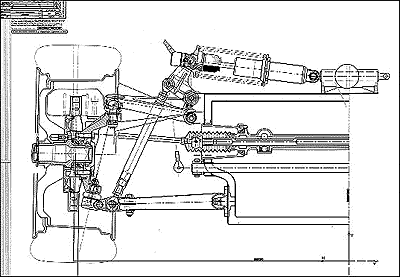
Investigation into the use of active dampers
This paper describes an investigation into the use of active dampers on heavy lorries. An experimental method known as `Hardware-in-the-Loop' simulation is used to test a semi-active damper under realistic operating conditions in the laboratory. A validated simulation of the damper is used to verify the hardware-in-the-loop method, and to investigate the performance requirements of semi-active dampers for heavy lorries. An investigation into the potential for reducing road damage by optimising the design of heavy vehicle suspensions is described. In the first part of the paper two simple mathematical models are used to study the optimisation of conventional passive suspensions.

Simple modifications are made to the steel spring suspension of a tandem axle trailer and it is found experimentally that RMS dynamic tyre forces can be reduced by 15% and theoretical road damage by 5.2%. A mathematical model of an air-sprung articulated vehicle is validated, and its suspension is optimised according to the simple models. This vehicle generates about 9% less damage than the leaf-sprung vehicle in the unmodified state and it is predicted that, for the operating conditions examined, the road damage caused by this vehicle can be reduced by a further 5.4%. Finally, it is shown experimentally that computer-controlled semi-active dampers have the potential to reduce road damage by a further 5-6%, compared to an air suspension with optimum passive damping. This report describes research into the control of vehicles fitted with idealised active suspensions and subject to road, steer and aerodynamic disturbance inputs. Two main issues are investigated: the achievable dynamic responses of the vehicle to each input; and (ii) the control of the vehicle to all the inputs simultaneously.

A half-car roll-plane model is used and a complete set of constraints is derived for a range of transfer functions and for a variety of measurements. Five independent inputs are considered: two road disturbance inputs; a steering disturbance input; and two aerodynamic disturbance inputs. Initially, each input is considered separately and it is shown that any dynamic response that can be achieved by measuring the disturbance input itself can also be achieved with certain other selected measurements, such as the suspension deflection and lateral acceleration. The control of the vehicle subject to all the disturbance inputs simultaneously is then considered. A set of measurements is chosen using the results of the independent analysis. A new set of constraints is derived using these measurements. It is shown that these new constraints only effect the transfer functions at arbitrarily high frequencies, and hence that all the inputs can be controlled to the full freedom available simultaneously, within the working range of the suspension. This paper describes research into the control of vehicles fitted with idealised active suspensions. The achievable dynamic response of a half-car roll-plane model subject to random road inputs is investigated. A set of performance constraints is derived for a range of transfer functions and for a variety of measurements. It is shown that in the case of vehicle roll, any dynamic response achievable by measuring the road profile can also be achieved with certain other selected measurements such as the suspension deflection in roll and the lateral acceleration. This paper describes research into the control of vehicles fitted with idealised active suspensions. The half car roll-plane model is investigated, and the achievable dynamic response of this model when subject to steering and side force disturbance inputs is evaluated. It is shown that for each input there is one degree of freedom available to the designer, i.e. that only one transfer function from that input to any output may be specified, all others are then fixed. It is further shown that for both inputs any response achievable using a full set of measurements, including the disturbance input itself, can also be achieved using measurements of suspension deflection in roll, and the lateral acceleration."

![]()